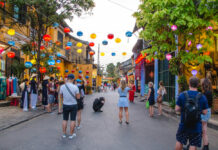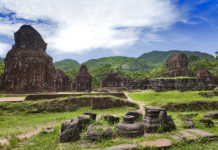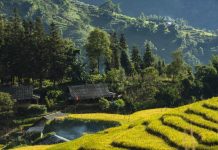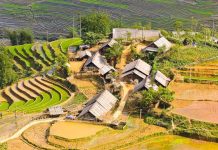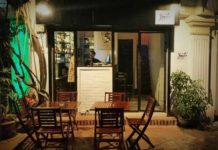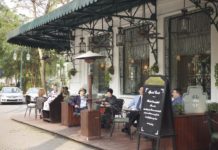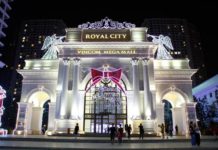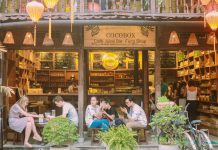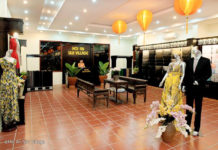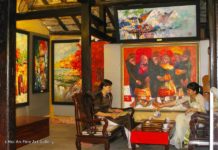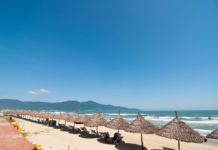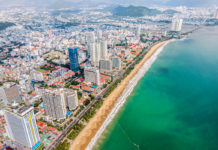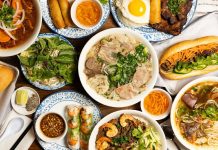Vietnam is a fascinating country in Southeast Asia that offers amazing landscapes, vibrant cities, rich culture and history, and delicious food. For families looking to explore this gem of a country, here is a perfect 10 days Vietnam itinerary covering the must-visit places in the north, central and south regions.
Detailed 10 Days in Vietnam Travel Itinerary
Day 1: Arrive in Hanoi | Explore Hanoi
- Arrive in Hanoi, the capital city of Vietnam
- Check into the hotel and relax
- In the evening, take a walking tour of the Old Quarter to soak in the atmosphere of the bustling streets lined with old tube houses, shops, and street food stalls. Don’t miss out on trying popular dishes like phở, bún chả, and bánh cuốn.
- Overnight in Hanoi
Day 2: Explore Hanoi
- Start your day with a visit to the Ho Chi Minh Mausoleum – the final resting place of Vietnam’s most iconic leader. Be sure to dress conservatively.
- Next up is the Temple of Literature, Vietnam’s first university built in 1070. Wander around the well-preserved temple and admire the traditional architecture.
- Have lunch at one of Hanoi’s restaurants. Cha Ca La Vong is a great place to try the local dish of turmeric fish.
- In the afternoon, visit the fascinating Ethnology Museum to learn about Vietnam’s 54 diverse ethnic minorities.
- In the evening, watch a traditional water puppet show to experience a unique Vietnamese art form.
- Overnight in Hanoi.
Day 3: Day Trip to Halong Bay
- Take a full day trip to Halong Bay from Hanoi. This UNESCO World Heritage Site is renowned for its emerald waters and limestone islands.
- Board a cruise boat and spend 4-5 hours sailing around magnificent rock formations like Dog Rock and Duck Rock. Go swimming, kayaking or just relax on the sundeck.
- Have a seafood lunch on board. Some cruises also offer cooking classes.
- Return to Hanoi in the evening.
- Overnight in Hanoi.
Day 4: Half-Day Trip to Tràng An Scenic Landscape Complex | Explore Hanoi
- In the morning, take a 4-hour excursion to Tràng An Scenic Landscape Complex – known as ‘Halong Bay on Land’ for its dramatic limestone mountains and valleys.
- Take a scenic boat ride to explore cave temples like Nhiem Son Cave and tranquil valleys.
- Return to Hanoi and visit the striking One Pillar Pagoda, built on stilts over a lotus pond.
- Next, take a walk around the historic Hoan Kiem Lake and Ngoc Son Temple.
- In the evening, attend the Thang Long Water Puppet Show.
- Sample some egg coffee, Hanoi’s unique drink, at Giang Cafe before turning in for the night.
Day 5: Fly to Phu Quoc Island | Relax at a Beach
- Take a morning flight to Phu Quoc, Vietnam’s picturesque island paradise.
- Check into your beachfront resort and spend the day relaxing on the white sand beaches lined with coconut palms. Long Beach and Sao Beach are the most popular.
- Take a dip in the tropical waters, go snorkeling to see coral reefs or get beach massages.
- As the sun sets, take a stroll at the night market in Duong Dong Town to shop for souvenirs.
- Overnight at Phu Quoc.
Day 6: Vinpearl Land Phu Quoc
- Spend the day enjoying the rides and attractions at Vinpearl Land, Vietnam’s biggest theme park located on Phu Quoc island.
- Thrilling rides like the Vinpearl Cable Car, Wave Surfer and Mambo Beach will appeal to kids and adults alike!
- Check out the 200+ animal species at Vinpearl Safari park and the aquarium.
- Catch one of the entertaining live shows like A O Show and Lang Toi Circus Show in the evening.
- Overnight at Phu Quoc.
Day 7: Fly to Ho Chi Minh City | Explore Ho Chi Minh City
- Take a morning flight to Ho Chi Minh City, Vietnam’s buzzing commercial hub.
- Explore top attractions like the Reunification Palace, Notre Dame Cathedral and Old Post Office.
- Visit the War Remnants Museum, a sobering reminder of Vietnam’s painful history.
- Shop at local markets like Ben Thanh Market to get souvenirs.
- In the evening, spend time in lively Bui Vien Street and try Vietnamese street food.
- Overnight in Ho Chi Minh City.
Day 8: Day trip to Cu Chi Tunnels & Mekong Delta
- In the morning, take a half day trip to the Cu Chi Tunnels located 70km from Ho Chi Minh City. This immense network of connecting tunnels were used by the Viet Cong during the Vietnam War. Walk through the narrow tunnels to understand the underground living conditions.
- Have a traditional Vietnamese lunch at a local restaurant.
- In the afternoon, take a scenic boat cruise in the Mekong Delta also known as the “Rice Bowl of Vietnam”. Cruise along lush green waterways and stop on islands to see cottage industries producing coconut candy and puffed rice.
- Overnight in Ho Chi Minh City.
Day 9: Half-Day Trip to Floating Market
- Take a morning trip to the famous Cai Be Floating Market, a unique wholesale market on the Tien Giang River. See vendors trading produce on boats.
- Visit local workshops making popsicles, coconut candy and puffed rice.
- Have lunch at a local Vietnamese home.
- In the afternoon, explore Ho Chi Minh City at leisure. Catch the sunset views from a rooftop bar.
- Overnight in Ho Chi Minh City.
Day 10: Explore Ho Chi Minh City | Fly Back Home
- Spend the morning shopping and seeing any remaining sights in Ho Chi Minh City.
- Have lunch at a restaurant. Nha Hang Ngon is great for sampling different Vietnamese dishes.
- In the afternoon, take your flight back home with wonderful memories from your Vietnam trip!
Other Best Places in Vietnam You Can Add to Your Itinerary for Vietnam
- Sapa – Ride the train through rice terraces and go trekking.
- Ninh Binh – See limestone mountains, temples and palaces.
- Hue – Explore imperial palaces and tombs.
- Hoi An – Discover this charming ancient town.
- Da Lat – Relax in Vietnam’s charming hill station.
- Mui Ne – Kitesurf or relax on sandy beaches.
Trip to Vietnam: How to Plan
Vietnam Visa
Vietnam Visa is an official document issued by the Vietnamese government that allows foreign nationals to enter and stay in Vietnam for a certain period of time. A visa is required for most travelers entering Vietnam, except for citizens of a few countries who are exempt.
There are different types of visas available, including tourist visa, business visa, and visa for work purposes. The duration of stay and requirements for each type of visa may vary.
To obtain a Vietnam visa, you can apply at a Vietnamese embassy or consulate in your home country or apply for an e-visa online. The requirements usually include a completed application form, a valid passport with at least six months of validity remaining, passport-sized photos, and the visa fee.
It is advisable to check the latest visa regulations and requirements before planning a trip to Vietnam, as they can change periodically.
Best Time to Visit Vietnam
The best time to visit Vietnam depends on the specific regions and experiences you desire. Generally, the country has three distinct weather patterns:
- Spring (February to April): This is considered the best time to visit as the weather is mild with less rainfall. It is an ideal time to explore popular destinations such as Hanoi, Halong Bay, Hoi An, and Hue.
- Summer (May to August): This period is hot and humid, especially in the central and southern regions. However, it can be a good time to explore the northern mountainous areas and take part in outdoor activities like trekking.
- Autumn (September to November): This is another great time to visit, as the weather becomes cooler and the rainfall decreases. It is an excellent time to explore destinations like Sapa, Ninh Binh, and the Mekong Delta.
It’s important to note that weather patterns can vary across the different regions of Vietnam, so it’s recommended to research specific destinations and their climatic conditions before planning your trip.
Vietnamese Currency
The currency of Vietnam is the Vietnamese đồng (VND). It is represented by the symbol “₫”. The đồng is one of the least valuable currencies in the world, meaning that you would need a large number of đồng to equal the value of a more valuable currency like the US dollar or the Euro.
The banknotes come in denominations of 500₫, 1,000₫, 2,000₫, 5,000₫, 10,000₫, 20,000₫, 50,000₫, 100,000₫, 200,000₫, and 500,000₫. The lower denominations (100₫, 200₫, 500₫) are rarely used due to their low value.
The exchange rate of the đồng to other currencies fluctuates regularly. As of September 2023, 1 US dollar is approximately equivalent to 24,000 VND. It’s important to note that prices in Vietnam are typically quoted in the thousands, and you may often find large numbers on price tags or in restaurant menus.
Foreign currencies, such as the US dollar or the Euro, are accepted by some hotels and restaurants in popular tourist areas. However, it is recommended to have Vietnamese đồng for most transactions, especially in smaller establishments or outside of tourist areas.
Overall, understanding the Vietnamese currency and having some local currency on hand will make it easier to navigate transactions and make purchases during your time in Vietnam.
Getting to Vietnam
To get to Vietnam, you have multiple options:
- By Air: The most common and convenient way to reach Vietnam is by air. Vietnam has several international airports, including Hanoi’s Noi Bai International Airport and Ho Chi Minh City’s Tan Son Nhat International Airport. You can book a direct flight to Vietnam from your country or connect through major transit hubs.
- By Land: If you are in a neighboring country, you can enter Vietnam by land. Cambodia, Laos, and China share border crossings with Vietnam. You can use buses, trains, or hired cars to reach Vietnam’s border checkpoints, and then proceed with the necessary immigration procedures.
- By Sea: Vietnam has several seaports that receive cruise ships and ferries from neighboring countries and other parts of the world. If you are on a cruise or prefer traveling by sea, you can check for available routes to Vietnam’s ports in Ha Long Bay, Da Nang, or Ho Chi Minh City.
Before traveling to Vietnam, ensure you have a valid passport and check the visa requirements for your nationality. It is recommended to consult with your local embassy or consulate for the most up-to-date information regarding visa regulations.
Getting Around Vietnam
Getting around Vietnam can be done in various ways, including:
1. Domestic flights: Vietnam has several domestic airports, making it convenient to travel between cities. Popular domestic airlines include Vietnam Airlines, VietJet Air, and Bamboo Airways.
2. Trains: Vietnam has an extensive railway network, with trains running between major cities and towns. The Reunification Express is the most well-known train route, connecting Hanoi and Ho Chi Minh City, with various stops along the way. Sleeper trains are available for overnight journeys.
3. Buses: Buses are a common mode of transportation in Vietnam, with both local and long-distance routes available. Local buses are affordable and can take you around cities, while long-distance buses offer connections between different regions of the country.
4. Motorbikes: Renting a motorbike is a popular option for travelers who want more flexibility and independence. However, be aware that traffic can be chaotic in Vietnamese cities, so riding a motorbike requires caution and experience.
5. Taxis and ride-sharing apps: Taxis are widely available in Vietnam, especially in urban areas. Ride-sharing apps such as Grab and GoViet are also popular and offer convenient transportation options.
6. Cyclos and motorbike taxis: Cyclos (three-wheeled bicycle taxis) and motorbike taxis (xe om) are popular modes of transportation for short distances within cities. Negotiate the fare before getting in to avoid overcharging.
7. Boats: In some regions of Vietnam, such as the Mekong Delta and Halong Bay, boats are a popular way to travel. Boat tours and cruises are available for exploring these areas.
While traveling around Vietnam, it’s important to keep in mind local traffic regulations, wear helmets if riding a motorbike, and be aware of your surroundings to ensure a safe and enjoyable journey.
FAQs
Is Vietnam safe for tourists?
Vietnam is very safe for tourists. Violent crime is rare and locals are very friendly towards tourists. As with any travel, just be mindful of petty crimes like pickpocketing and bag snatching in crowded areas.
Is Vietnam affordable?
Yes, Vietnam is an extremely budget-friendly country. Accommodation, local transport, street food and even tours are quite cheap compared to other Southeast Asian countries.
What vaccines are needed for Vietnam?
No vaccinations are mandatory for Vietnam but recommended ones are Hepatitis A, Typhoid and Tetanus. Malaria medication may be taken if traveling to rural regions.
What is the best way to get around Vietnam?
For long distance travel between cities, fly or take overnight trains/buses. Within cities, walk or take metered taxis and ride hailing apps. Motorbike rental is popular but require skills. Cyclo tours are fun too.
What should I pack for Vietnam?
Pack light, breathable cotton clothes. Bring sunscreen, insect repellent, prescription medicines, universal power adaptors, small umbrella for rain, and breathable shoes.
Conclusion
With its emerald rice fields, dramatic coastline, cave-riddled limestone mountains and bustling cities, Vietnam is a delight to explore. This 10 day Vietnam itinerary packs the best of Northern, Central and Southern Vietnam through a mix of culture, history, nature and relaxation. From cruising Halong Bay to slurping phở in Hanoi and exploring vibrant Ho Chi Minh City, this trip allows you to experience the best of Vietnam. With additional time, also explore Sapa, Hoi An and other gems for a complete experience.

